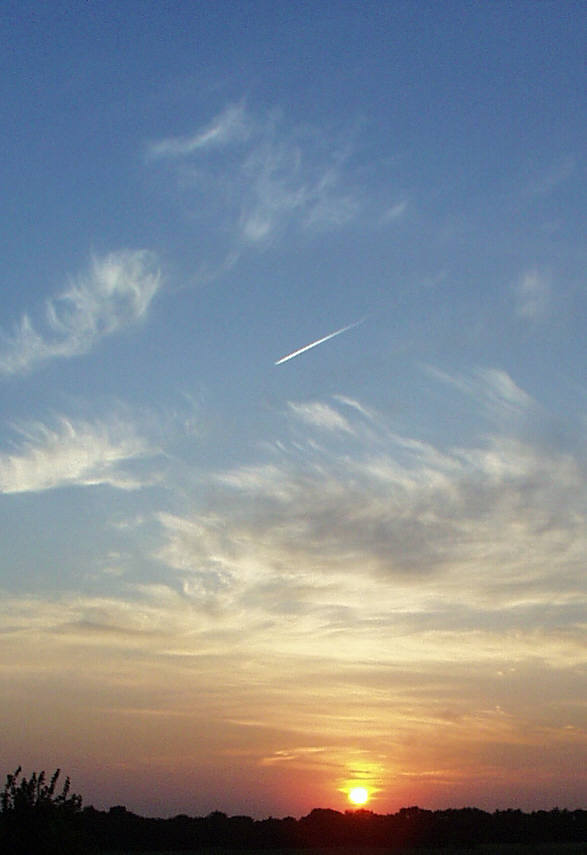|
|
RECENT EVENTS (since 2014)
...too many things to do, too little time to record...
...but here's some examples...
|
|
|
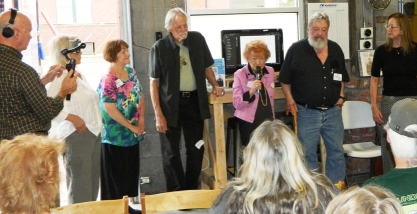
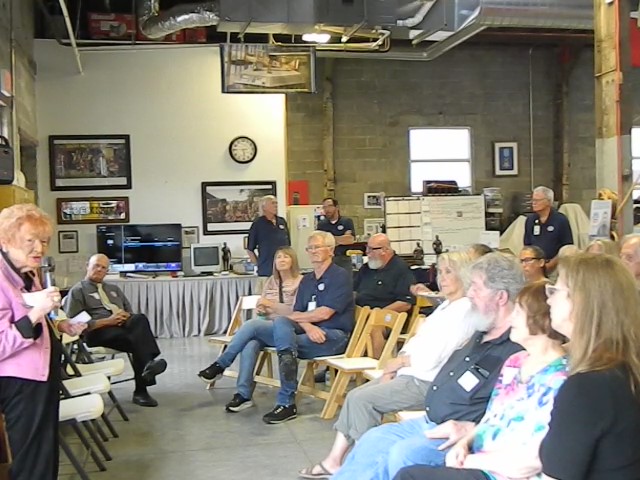
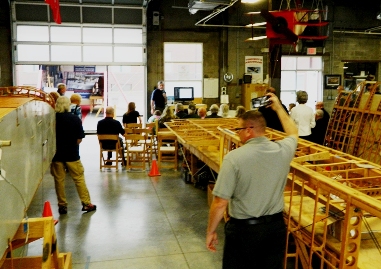
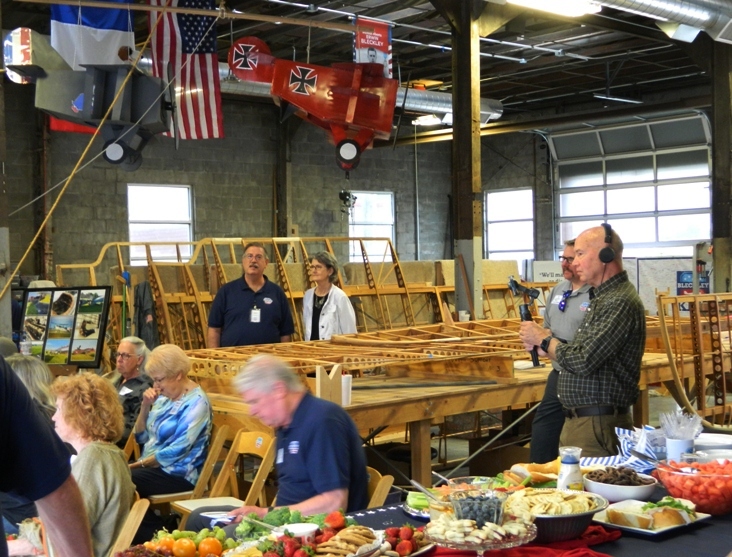
|

Bleckley Foundation - Arts Soiree'
October 6, 2025
The
Bleckley Airport Memorial Foundation
(BAMF) invited me to their private reception with legendary local sculptor
Babs Mellor,
whose monumental sculptures are
Wichita icons.
The Foundation is preparing a permanent public exhibit to honor Wichita's Medal of Honor aviator (one of America's first),
Lt. Erwin Bleckley,
who gave his life in World War I, attempting to rescue the desperate
Lost Battalion.
In addition to BAMF's restoration of a rare DH-4 biplane to match Bleckley's, their exhibit will include a life-size bronze statue of Bleckley, crafted by Mellor and her team of volunteers.
BAMF founders -- military veterans Doug Jacobs and Greg Zuercher -- introduced their cast of volunteer craftsmen and engineers, while Mellor introduced her team of artists, who have enthusiastically volunteered their time and talents for the arduous project. Q&A sessions followed, and
a TV documentary about Mellor
was shown.
The exclusive private reception connected BAMF volunteers with local arts, media and political elites, inside the massive BAMF aircraft restoration workshop in Old Town. With fabulous spreads of gourmet eats, beneath flags and banners, amidst the workshop's staggering array of antique aircraft elements, much was learned, and new friendships were made.
|
|
|



Photos courtesy of Dale Krebbs,
Charter Marketing
|
EAA88's annual Air Capital Fly-In
August 30, 2025
I was invited to serve as the announcer for the
62nd annual Air Capital Fly-In, at Jabara Airport.
Sponsored by the
EAA's local Chapter 88
(one of the nation's oldest), it was a mix of pilots, aviation industry leaders and workers, aviation cadets, and families
just having fun.
While adults bought helicopter rides, kids were given
free "Young Eagles" rides
by highly qualified EAA pilots. A B-52 simulator and an F-14 cockpit were attractions, along with the
Bleckley Foundation
mobile museum, the Lear Jet Foundation's exhibits (they're restoring the first sold Learjet), and others.
Evening banquet speaker, "The World's Greatest Fighter Pilot" author Col. Ed Sykes (former Kansas Air National Guard commander at McConnell AFB), regaled the diners with tales of his adventures with X-1 pilot Chuck Yeager, and first Space Shuttle commander, Kansan Joe Engle, with photos.
I made the necessary announcements, plugged sponsors and vendors, added descriptive "color commentary" about the planes as they flew by, DJ'd the background music (with help from Bill G.) and interviewed aviation notables at the event. Fun work for great folk.
|
|
|
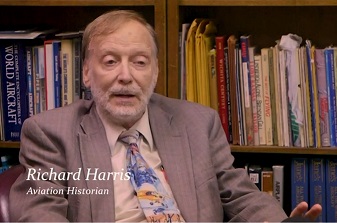
|
Kansas Crossroads TV show,
June/July 2022
I was interviewed for the Wichita aviation history segments, of the Wichita-history episodes, of the local TV series "Kansas Crossroads" -- produced by historians Ken Spurgeon and Susan Walenta, for the Butler County Historical Society and other sponsors. My interview/narration in the episode "The Birth of the Air Capital" first aired, Sunday, July 10, 2022, at 10:30 AM on KWCH-TV Channel 12-1, in Wichita. I provided additional information and imagery for the episode, and for another one following.
|
|
|
Butler County Air Park Fly-In
June 2022
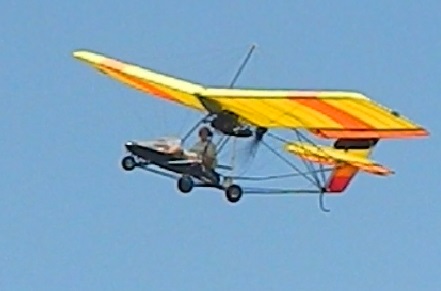
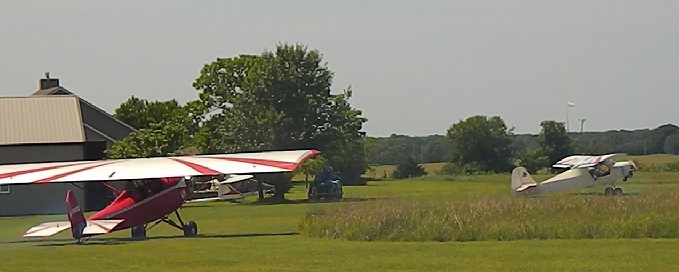
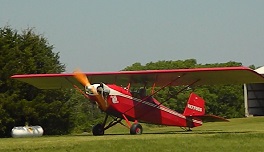
|
Colleague Brian Fitzgerald, known for his ultralight videos as the "Sky Surfer", invited me to his rural private airpark -- homes surrounding a nice grass strip -- for their annual fly-in.
A nifty variety of ultralights, light-sport, and certified planes appeared -- including Brian's brilliant-yellow Quicksilver MX ultralight and two-seat RANS S-12, to a Kitfox, Don Forse's speedy little Titan Tornado, a classic Cessna 120/140, and Chuck Gantzer's show-smokin' red Pietenpol.
Taking a break from the heat, we retired to the Fitzgeralds' air-conditioned observation lounge, admiring the aerial artistry of the local natural aviators (hummingbirds to vultures), while local legend Doug Moler -- who's flown everything from ultralights to jumbo-jetliners -- regaled the party with tales of Boeing 747 peculiarities.
Looking for a nice place on a remote grass strip? I hear there's a house for sale out there -- and a hangar. Brian or Chuck knows.
|
|
|



|
Bleckley Memorial Project & DH-4 Restoration,
2021-2025
In World War I, a Wichita-native aerial observer -- Lieutenant Erwin Bleckley -- and his pilot, Harold Goettler -- sacrificed their lives in an attempt to locate and aid the legendary "Lost Battalion" (Allied troops surrounded in the Ardennes forest, being decimated by enemy attacks, and unable to signal their location to allies). Flying low into intense enemy fire, to try and find the battalion, and drop supplies to them (as part of America's first aerial resupply mission), their first foray resulted in 40 bullet holes to their plane, before they were forced to retreat.
Later that day, though, they insisted, against their commander's advice, to try again -- Bleckley first making out his will, then announcing they would find the Lost Battalion, or die in the attempt. This time, though, the hail of gunfire caught them, and their plane crashed just outside enemy lines -- Goettler dying instantly, Bleckley in an ambulance. It was an act of such bravery that it captured the imagination of the era, and the two were posthumously awarded the Medal of Honor -- the nation's highest honor for military valor -- becoming two of the first four American aviators, ever, to be so honored.
Though largely overshadowed by his hometown's aviation industry, this Wichita aviation hero has not been completely forgotten -- and two stalwart retired Army veterans (Lt. Col. Doug Jacobs and SSgt Greg Zuercher) have conspired to develop commemorations of Bleckley -- particularly the restoration of an extremely rare Airco/deHavilland
DH-4 biplane bomber,
same as that flown by the daring duo, for prominent display in Wichita, in their honor.
In developing their Bleckley Foundation, they wanted to get as precise a knowledge of the history of Bleckley, and the plane, as possible -- and to refine their expertise in local aviation and civic affairs. They formed an advisory committee to help guide their project, and asked me to join. The honor was accepted and we've since engaged on numerous topics in the program -- developing a clearer, broader historical perspective, understanding FAA regulations, finding resources in distant aviation enterprises and local civic circles, making the most of media opportunities, and much more.
|
|
|
High Flight, Summer 2021
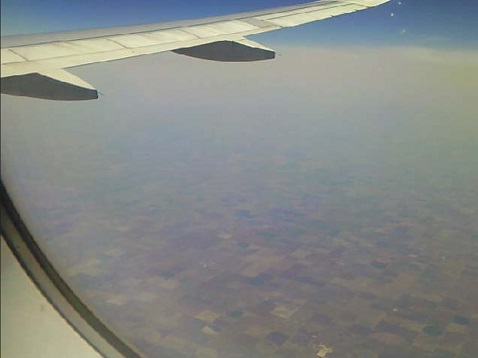
|
On a cross-country trip by Airbus jetliner, I got to see the earth from a much higher vantage point than I usually do. From 30,000 feet, the square-mile patches of farmland, small-looking from a glider (see below), look almost microscopic from a jetliner at cruising altitude.
Whole states were visible in a single glance -- mountains and canyons, rivers and valleys, cities and countryside. Another rare treat: We witnessed a thunderstorm from above, looking down on lightning bolts as they pierced the sky.
It was amazing to see, too, how fast it all passed by, compared to traveling in a light aircraft. It was especially dramatic as we passed by an oncoming airliner streaking by the opposite direction, in an adjacent air lane -- in mere seconds (the combined speeds of the two planes was a likely closing speed of over 1,000 miles per hour).
Of course there was the tedious melodrama of navigating terminals on both ends, and the extremely cramped quarters in a budget-seating arrangement. But it was worth it.
|
|
|
Glider Rider, March 2020
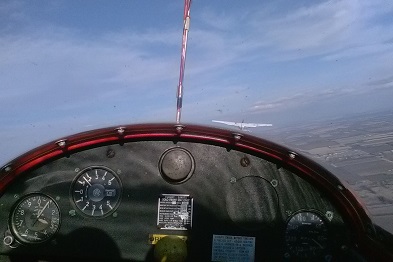
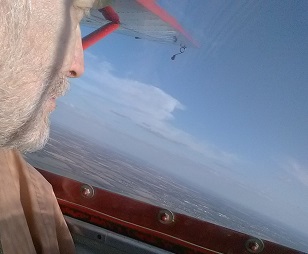
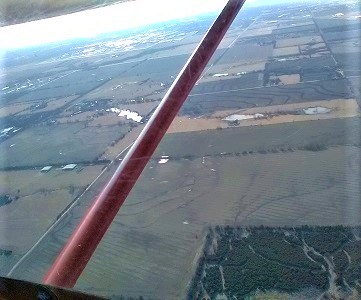
|
On a lovely Spring day in Kansas, our sturdy Schweizer 2-22 glider was hauled aloft by the Wichita Glider Club's stout Cessna 185. Reaching 3,000 feet above the flatlands, we cut him loose. Veteran glider instructor (and Cessna engineer) Charlie Pate, and I, toured the thermals for a grand view of the territory, as the air whispered past our silent sky skimmer.
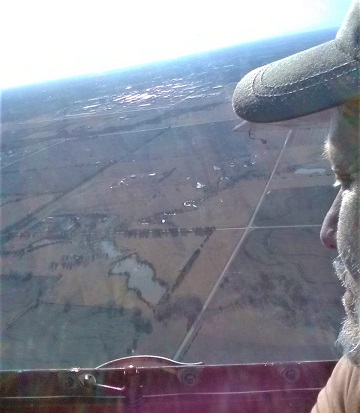
|
|
|
EAA AirVenture Fly-In & Convention
Oshkosh, Wisconsin, - July 27 – Aug.3, 2014
|
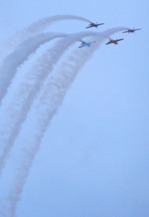
"The world's biggest aviation celebration," the EAA AirVenture in Oshkosh, Wisconsin — a dazzling, complex array of every aviation technology, hundreds of aircraft, thousands of aviators, and half a million other people — is the annual mecca for the general aviation world.
Every aviator is half-expected to make a pilgrimage there at least once in his/her life.
I finally got around to it -- as one of the hundreds of people working the event, for the whole week.
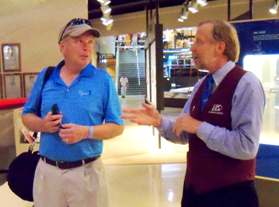 As a volunteer "docent" at the EAA Museum, I did lots of "drudge chores," but also got to spend hours with visitors from around the world, happily explaining the history and significance of the staggering array of historic aircraft and other exhibits in this world-class aviation museum.
As a volunteer "docent" at the EAA Museum, I did lots of "drudge chores," but also got to spend hours with visitors from around the world, happily explaining the history and significance of the staggering array of historic aircraft and other exhibits in this world-class aviation museum.
For more pix, videos and stories from AirVenture 2014, from the EAA (Experimental Aircraft Assn.),
CLICK HERE.
|
CLICK PHOTOS to ENLARGE
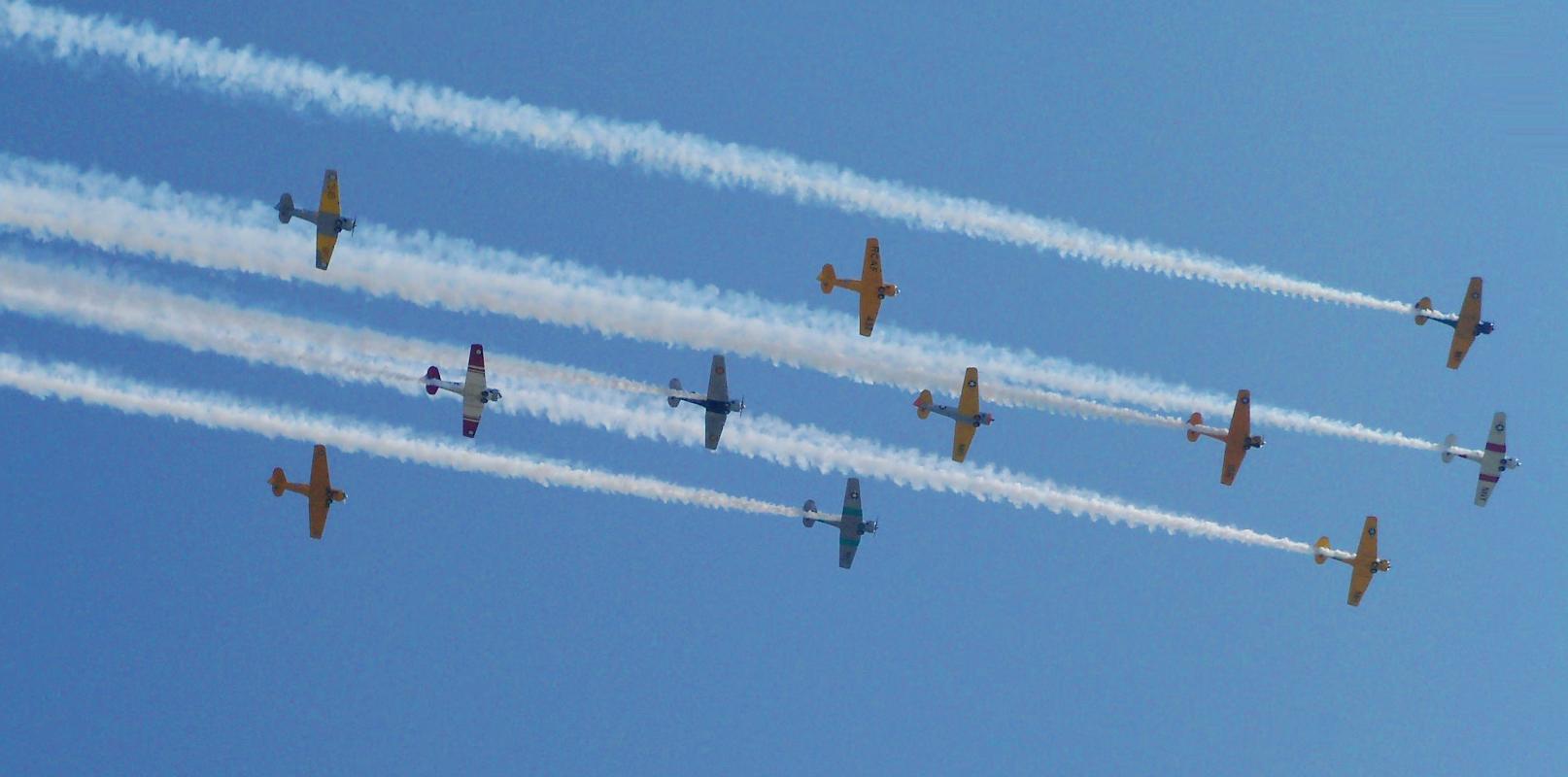

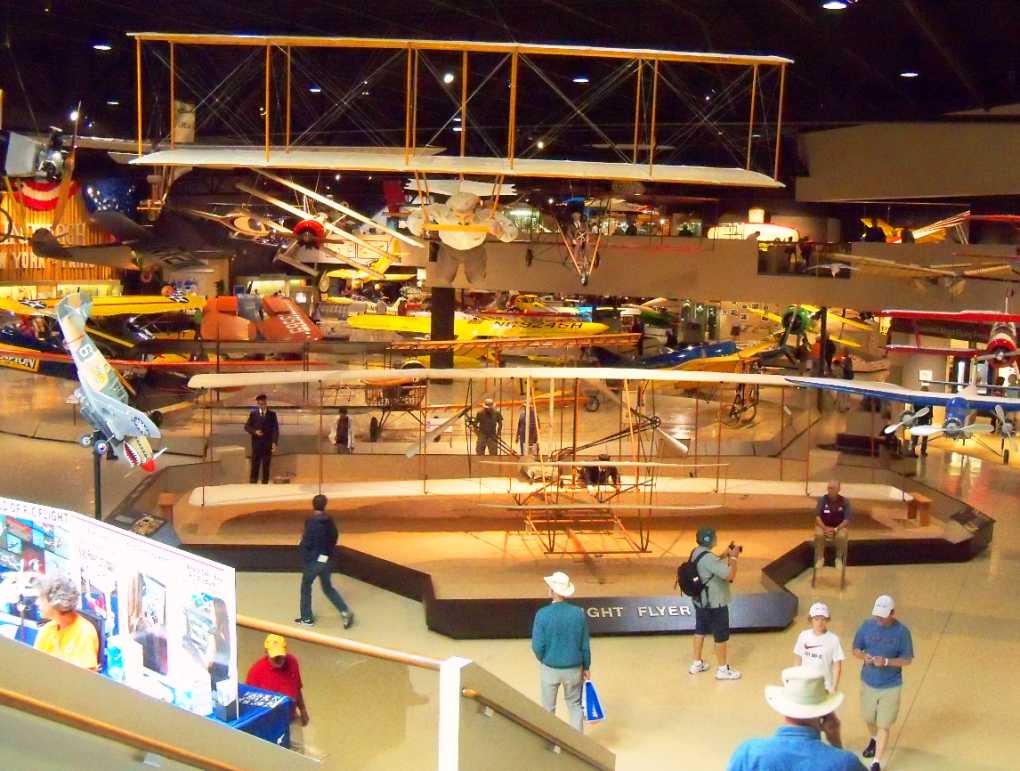
|
|
|
The Missing Years
- 2010-2014
|
With too many responsibilities, and too little time for photo-fun, I've spent the last few years doing more than I had time to photograph (photographs from 2010, and before, resume below). Here are some samples, mostly linking to others' websites:
-
2012-2014 - DOCUMENTARY FILM CONSULTING. For some reason, several people are coming to me with their aviation history documentary projects. Most notable among them:
-
Indians in Aviation, 2014, by filmmaker Doug Robertson. This documentary focuses chiefly on the diverse array of Native Americans who immigrated to Wichita, Kansas, during World War II, to help build "the planes that won the war," and tells the story of the radical transfomation of their lives that reflected the radical change in Wichita brought by war.
I helped with historical consulting and image-hunting,
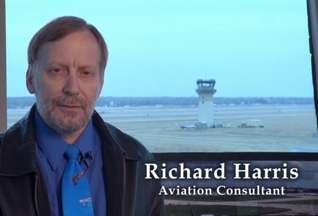 and provided some on-camera historical commentary.
The film was
presented at the Mid-America All-Indian Center (where an excerpt is part of a semi-permanent exhibit), and won a place in the 2014 "Red Nation" American Indian film festival.
See the trailer, here. For more, from the Wichita Eagle newspaper,
CLICK HERE
and provided some on-camera historical commentary.
The film was
presented at the Mid-America All-Indian Center (where an excerpt is part of a semi-permanent exhibit), and won a place in the 2014 "Red Nation" American Indian film festival.
See the trailer, here. For more, from the Wichita Eagle newspaper,
CLICK HERE
-
Aviation Rising:
Community in Motion — 2012,
a cooperative project on America's "Space Coast" (the spaceflight-industry community around America's historic spacecraft launch site: Cape Canveral, Florida) -- joining the forces of the area newspaper (Florida Today), the local college (Brevard Co. Community College — now Eastern Florida State College ), and local public television, in a community "brainstorming" project to examine options for this community suddenly faced with the collapse of the
 Space Shuttle program, and the layoff of 24,000 aerospace industry workers.
Space Shuttle program, and the layoff of 24,000 aerospace industry workers.
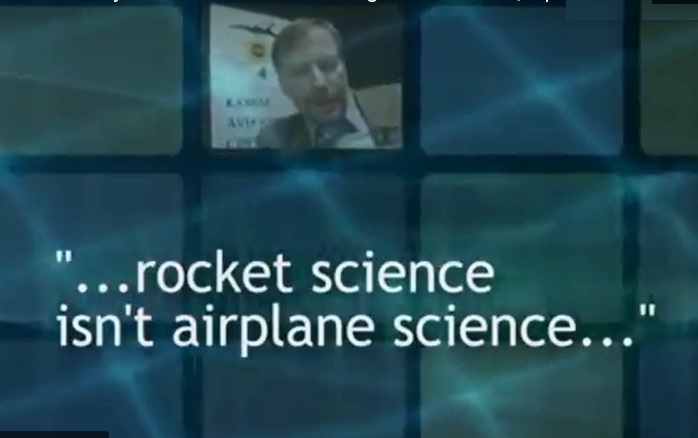 Noting my knowledge of Wichita's aviation industry, and its history, they sought my commentary, in print and on-camera, about the prospects of creating another "Air Capital City" on the Space Coast. (Reflecting on the difficulties of establishing an Air Capital, past and present, I encouraged them to focus efforts, instead, on becoming the "Alternative Energy Capital," based on their special skills, resources and market realities.)
For more,
CLICK HERE.
Noting my knowledge of Wichita's aviation industry, and its history, they sought my commentary, in print and on-camera, about the prospects of creating another "Air Capital City" on the Space Coast. (Reflecting on the difficulties of establishing an Air Capital, past and present, I encouraged them to focus efforts, instead, on becoming the "Alternative Energy Capital," based on their special skills, resources and market realities.)
For more,
CLICK HERE.
-
 Flying the Beam: Portrait of a WASP
traces the life of a Womens' Army Service Pilot of World War II. Producer found my website helpful in explaining some of the navigation technology of the time, and asked to use or adapt some of my artwork. Also provided additional historical, artistic and technical consulting, photo and footage sourcing, and some script.
Flying the Beam: Portrait of a WASP
traces the life of a Womens' Army Service Pilot of World War II. Producer found my website helpful in explaining some of the navigation technology of the time, and asked to use or adapt some of my artwork. Also provided additional historical, artistic and technical consulting, photo and footage sourcing, and some script.
-
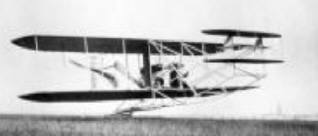 The Wright Brothers and the Development of Aircraft Structures, a history project, by a group of Indonesians, for National History Day (an American educational event now observed in nations around the world).
The Wright Brothers and the Development of Aircraft Structures, a history project, by a group of Indonesians, for National History Day (an American educational event now observed in nations around the world).
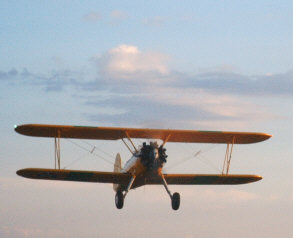 ...AND LONG AGO:
...AND LONG AGO:
- The Barnstomers: Pioneers of the Skies: As long as we're covering documentaries I've assisted, we might note The Barnstomers, a documentary about early aviators and airplane-makers, and their modern-day counterparts, which I helped with in 2003. See below, after the 2003 National Air Tour story.
- 2010-2014 AVIATION HISTORY JOURNAL ARTICLES:
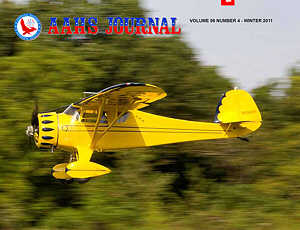
2010-2012: KANSAS AVIATION HISTORY COMMEMORATION:
-
2011-2012: Kansas Aviation Centennial Chairman
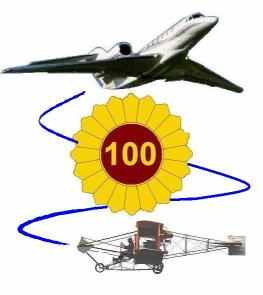
Overlapping the Kansas Sesquicentennial (below), was the Kansas Aviation Centennial, which began in 2011 -- the anniversary of one of the most powerful influences
in U.S. and world aviation history. On September, 2nd, 1911,
the first aviator and plane-maker, to fly from Kansas soil, Albin K. Longren, took off from a field near Topeka, in the first successful Kansas-built airplane.
Longren began a hugely influential (but seldom noted) career in airplane design and manufacturing — developing and patenting the core technologies used to build today's modern airplanes — and spread the technology throughout Kansas and the nation.
 Others soon exploded Kansas into a national plane-making center: Laird, Swallow, Travel Air, Stearman, Cessna, Beech, Mooney, Porterfield, Culver, Funk, Boeing, North American, Republic, Learjet, Bede, Rutan and more. By the end of the century, Kansas had produced aircraft of every type — over a quarter-million in all — and Wichita had become the "Air Capital City," the world's highest-quantity producer of aircraft.
Others soon exploded Kansas into a national plane-making center: Laird, Swallow, Travel Air, Stearman, Cessna, Beech, Mooney, Porterfield, Culver, Funk, Boeing, North American, Republic, Learjet, Bede, Rutan and more. By the end of the century, Kansas had produced aircraft of every type — over a quarter-million in all — and Wichita had become the "Air Capital City," the world's highest-quantity producer of aircraft.
Somehow, all the "official" parties who would normally be expected to commemorate this Centennial — government officials, industry leaders, academic experts and institutions, museums and media — simply overlooked it.
So, at the last minute, I organized the "Kansas Aviation Centennial Committee" (including a panel of expert historians --
Kansas Aviation Museum Curator Walt House,
senior aviation executive, airplane designer and historian
Kent Rowe,
WSU History Professor
Jay Price,
and international aviation historian John Davis
-- to verify the date of the Centennial), and did a promotional "blitz," building a website (partly echoed
here),
posting
articles, putting out the word to the media and industry organizations
across the state, and scheduling a "Centennial Kick-Off" event for the public. It was less-than-spectacular, and the Governor couldn't make it in time (though he did send a belated proclamation),
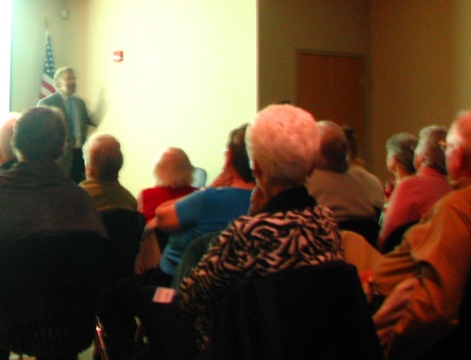 but it was the only truly public commemoration of the anniversary in the state that month. Some key media responded, including newspapers who produced detailed features on the historic anniversary: the
Wichita Eagle
and
Topeka Capital-Journal.
but it was the only truly public commemoration of the anniversary in the state that month. Some key media responded, including newspapers who produced detailed features on the historic anniversary: the
Wichita Eagle
and
Topeka Capital-Journal.
Over the next "Centennial" year I made various minor efforts to promote recognition of the milestone, state-wide and nationally. I gave a few presentations, and participated in a few aviation events to bring a bit of Kansas aviation history to light at them.
 My assignment as a speaker for the Kansas Humanities Council (see below), provided a platform for further presentations on the theme. I continued to help promote, via the KAC website and other media activity, any aviation event
with a Kansas aviation history angle, even integrating it into a brief bit of announcing at the 2012 National Biplane Fly-In in Junction City.
My assignment as a speaker for the Kansas Humanities Council (see below), provided a platform for further presentations on the theme. I continued to help promote, via the KAC website and other media activity, any aviation event
with a Kansas aviation history angle, even integrating it into a brief bit of announcing at the 2012 National Biplane Fly-In in Junction City.
For my photos from the National Biplane Fly-In,
CLICK HERE
For more on the Kansas Aviation Centennial,
CLICK HERE
-
 2010-2012:
2010-2012:
Kansas Aviation History Speaker
for the Kansas Humanities Council
for "Kansas 150"
- the Kansas Sesquicentennial.
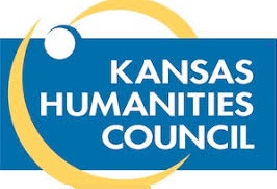 Kansas turned 150 years old in 2011, and the two-year-long celebration, from 2010 to 2012, called for extra
attention from the state's humanities council, which provides expert speakers on various topics of Kansas history for public presentations throughout the state. Noting my
Kansas turned 150 years old in 2011, and the two-year-long celebration, from 2010 to 2012, called for extra
attention from the state's humanities council, which provides expert speakers on various topics of Kansas history for public presentations throughout the state. Noting my
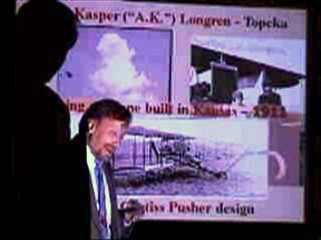 prior work on the topic, they invited me to develop and give the presentations on the history of the Kansas aviation industry. Over the next two years, I gave slideshow / lecture presentations to hundreds of Kansans at museums, colleges and other public venues across the state. Along the way, I met some interesting people who had lived and made Kansas aviation history, and learned from them.
prior work on the topic, they invited me to develop and give the presentations on the history of the Kansas aviation industry. Over the next two years, I gave slideshow / lecture presentations to hundreds of Kansans at museums, colleges and other public venues across the state. Along the way, I met some interesting people who had lived and made Kansas aviation history, and learned from them.
For more,
CLICK HERE
|
|
|
FlightSafety (HawkerBeechcraft) Maintenance Training Center
PAMA Grand Tour
- Jan 19, 2010
|
|
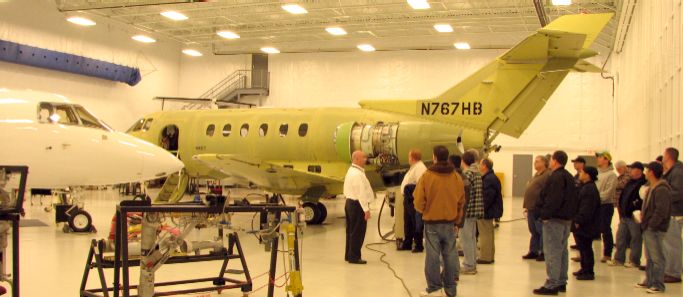

|
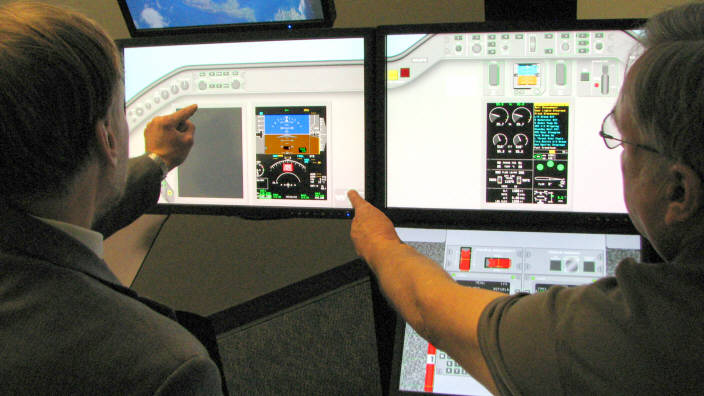
Several of the world's most modern, high-tech, general aviation training facilities are based in Wichita. Here's an example.
The Wichita Chapter of the
Professional Aviation Maintenance Assn. (PAMA), was generously invited by
FlightSafety International (FSI) to tour their new
Hawker-Beechcraft Maintenance Training Center, adjacent to Beech Airport -- and sample a bit of their instructional offerings.
PAMA techs got to see the latest in aerospace training, for some of the most advanced aircraft flying today.
I managed to get a chance to "test drive" the simulator for the most advanced business jet flying today.
For more,
CLICK HERE
|
|
|
Amelia Earhart
TV Interviews
Kansas State Network,
KSN-W TV Channels 3 & 22,
Wichita, KS,
Dec.2009
|
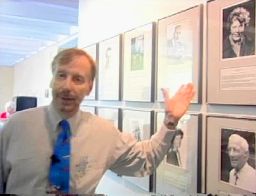
|
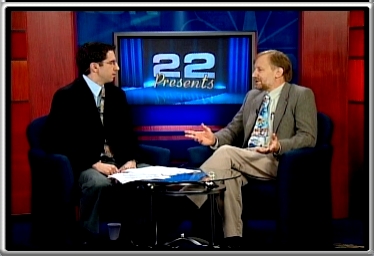 With the 2009 debut of the motion picture "Amelia," interest in the show's real-life subject, Kansas aviatrix Amelia Earhart -- the most famous of women aviators -- saw a resurgence.
With the 2009 debut of the motion picture "Amelia," interest in the show's real-life subject, Kansas aviatrix Amelia Earhart -- the most famous of women aviators -- saw a resurgence.
Kansas State Network's TV Channel 3 interviewed me about Earhart, in the Kansas Aviation Hall of Fame, at the Kansas Aviation Museum. Later, KSN's News Director invited me to appear on his Cable 22 news magazine show, for an extended discussion of Earhart's colorful life, and her deep Kansas connections.
For more,
CLICK HERE
|
|
|
Bombardier's 2009 Safety Standdown
Wichita Hyatt Hotel & Convention Center, Sept.28 - Oct.1, 2009
|
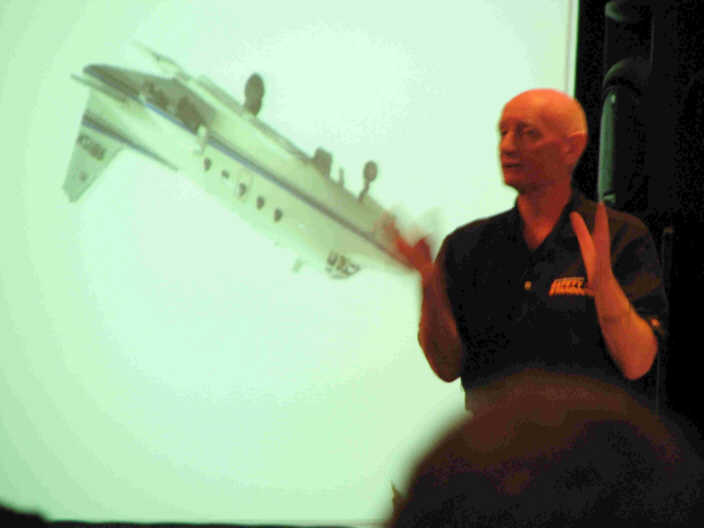
|
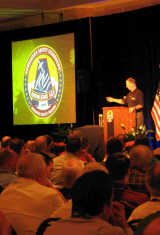 The maker of Learjet and Challenger bizjets sponsors this annual week-long safety seminar for nearly 400 bizjet pilots, mechanics and flight dept. chiefs, from around the world -- billed as a sort of "Top Gun" school for corporate and charter jet pilots.
The maker of Learjet and Challenger bizjets sponsors this annual week-long safety seminar for nearly 400 bizjet pilots, mechanics and flight dept. chiefs, from around the world -- billed as a sort of "Top Gun" school for corporate and charter jet pilots.
Keynoted by speeches from the heads of the FAA and NTSB, an army of leading aviation industry safety experts give detailed technical safety presentations -- plus safety briefings and "there I was" stories from NASA experts and astronauts.
I attended all four days, and interviewed most of the speakers.
For more,
CLICK HERE
|
|
|
2008 American Barnstormers' Tour
Sept. 1, 2008, Jabara Airport, Wichita
|
|

|
|
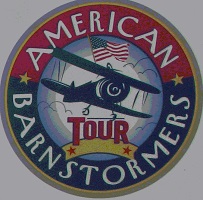
 Above, a pair of early-1930s Stearmans converge, as a red WACO approaches. Below, Hank Galpin and his grand 6-seat (plus tiny bathroom) 1928 Travel Air 6000B (I'm in the pilot's seat, in the photo at right). At bottom is a Stinson Junior, a big, roomy 4-5 seater of the early 1930s. Not shown: a luxurious red WACO cabin biplane.
Above, a pair of early-1930s Stearmans converge, as a red WACO approaches. Below, Hank Galpin and his grand 6-seat (plus tiny bathroom) 1928 Travel Air 6000B (I'm in the pilot's seat, in the photo at right). At bottom is a Stinson Junior, a big, roomy 4-5 seater of the early 1930s. Not shown: a luxurious red WACO cabin biplane.

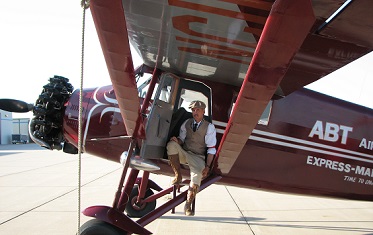
|
Above, left-to-right, a red "Bull" Stearman 4, blue Waco, orange/white Travel Air 4000, (back) red/white Fairchild 22, silver/red Steaman Speedmail. A red open-cockpit WACO hides behind a green, 5-seat New Standard D25S; and a big, blue 1929 Travel Air 4000 is up front. Below, a gleaming white 1928 Travel Air flys overhead.
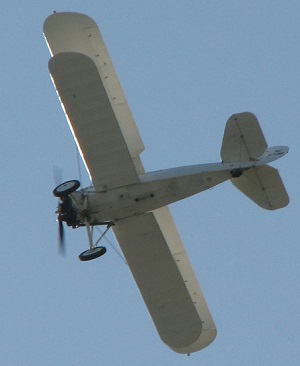
As an aviation historian, my favorite topic is the early years of U. S. general aviation -- the years of barnstorming, the emergence of personal aviation and the first "business" aircraft -- the years that created the legendary names of U.S. general aviation, many of them once-famed names, now mostly lost to modern memory.
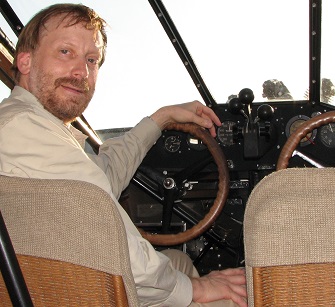
It's one thing to study the historic record about planes of the "Golden Age" between the world wars, especially the pioneering aircraft of the 1920s and early 1930s. It's another thing altogether to get to inspect the real, living, breathing, flying machines themselves, on the ramp of my local airport.
But a handful of passionate restorers, aviators and owners have breathed new life into old airframes that -- by the odds -- should be rotting in the shadows of a museum. Among these are the colorful, gleaming rag-wing wonders of the American Barnstormers' Tour, which, starting in 2008, largely echoes the 2003 recreation of the 1920s' National Air Tour (see below), with some of the same planes, and many others — all genuine aircraft of the 1920s and 1930s!
Not content to be historic artifacts, these craft fly! And as a traveling troupe, circling the heartland of the U.S., they are truly a "flying circus." Arriving in period garb, their crews eagerly show off the craft, and sell rides just like barnstormers of old. Arranging a layover in Wichita, they gave me a chance to get acquainted with pilots and planes, and learn so much more about the craft I'd studied and written about, for years, almost purely from written sources. This was so much more exciting!
After getting acquainted with me, one of the group invited me to join them for the rest of the tour. What an invite!
|
|
|
2008 Wichita Flight Festival
August 29-31, 2008, Jabara Airport, Wichita, KS
|
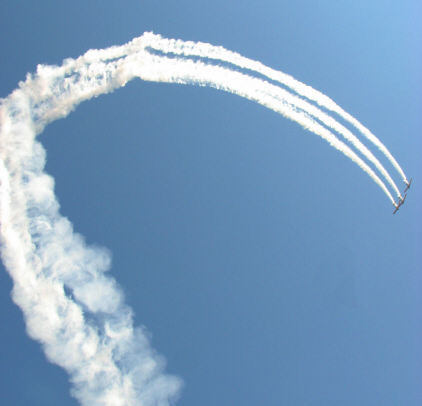
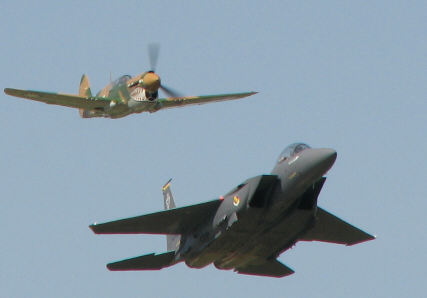

|
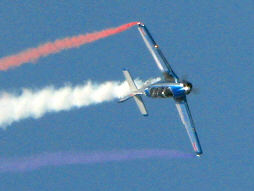 Wichita's a truly good airshow town, when it has one. The 2008 Wichita Flight Festival gathered some of the most famous names in the airshow biz: Patty Wagstaff, John Mohr, Julie Clark, Corky Fornof, Greg Shelton & Ashley Battles, the Red Eagles, the Aeroshell T-6 team, and more, for a three-day spectacle.
Wichita's a truly good airshow town, when it has one. The 2008 Wichita Flight Festival gathered some of the most famous names in the airshow biz: Patty Wagstaff, John Mohr, Julie Clark, Corky Fornof, Greg Shelton & Ashley Battles, the Red Eagles, the Aeroshell T-6 team, and more, for a three-day spectacle.
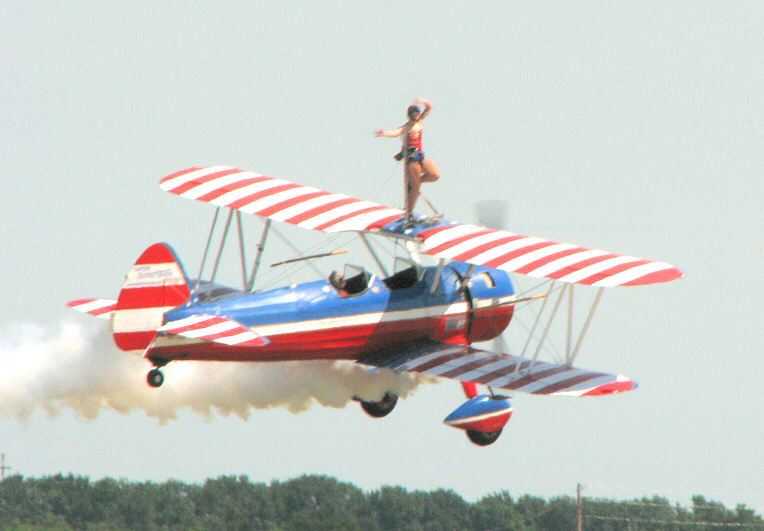
As asssistant announcer (adding local and historic "color commentary"), I got to work alongside airshow boss Wayne Boggs and announcer Danny Clisham (both legendary stars of these roles at EAA AirVenture, at Oshkhosh, Wisconsin -- the world's biggest annual fly-in and airshow).
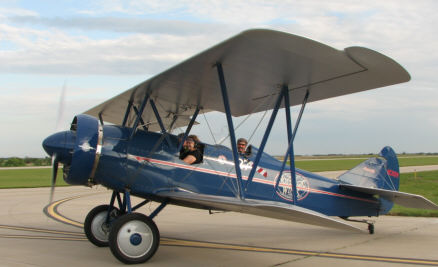 So many great sights to shoot, and so little free time! My photos are supplemented with brilliant work by photographer/buddies Kira Corteville, and Steve & Sheri Alexander.
So many great sights to shoot, and so little free time! My photos are supplemented with brilliant work by photographer/buddies Kira Corteville, and Steve & Sheri Alexander.
For more,
CLICK HERE
|


|
|
|
Biplane Association of America
Annual Fly In
Frank Phillips Field, Bartlesville, Oklahoma -
Summer 2008
|

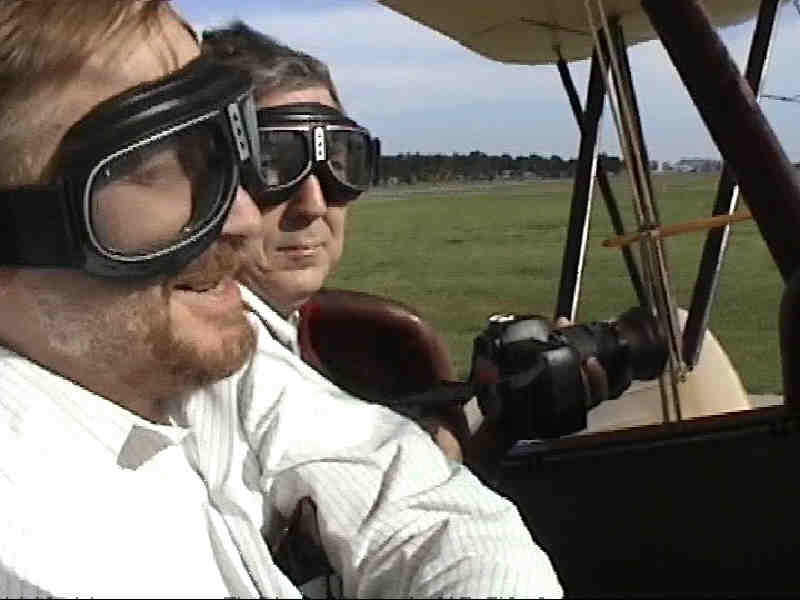 One of the great gatherings of double winged birds, this was the last of BAA's annual national fly-ins in Bartlesville, Okla. Dozens of vintage and modern biplanes of every type flocked to the field, showing off and cavorting in the sky. A few sold rides, and we took one!
For more,
CLICK HERE
One of the great gatherings of double winged birds, this was the last of BAA's annual national fly-ins in Bartlesville, Okla. Dozens of vintage and modern biplanes of every type flocked to the field, showing off and cavorting in the sky. A few sold rides, and we took one!
For more,
CLICK HERE

|
|
|
|
|
Airbus A380 Pays Its Respects to Air Capital Engineers
October 4, 2007
|
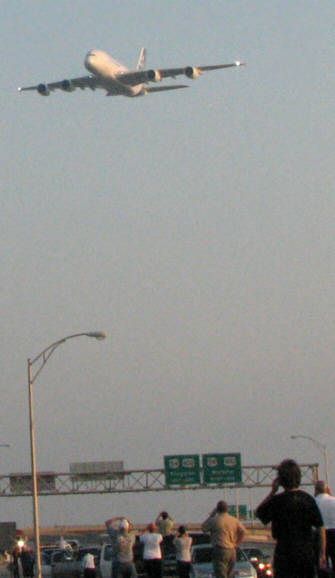
|

The world's largest airliner -- the new Airbus A380 double-decker jetliner -- is largely the product of Wichita engineers. Here, Airbus engineers designed the most precise and complex section of the super-jumbo's massive frame: its giant wing.
On its first North American trip, the A380 -- to salute Wichitans' work -- flew a couple of low passes over Wichita's Mid-Continent Airport, as Wichita Airbus engineers -- and people from throughout the Air Capital City (including this reporter) -- watched from below.
For more,
CLICK HERE
|
|
|
|
60th Annual Fly-In of the
International 195 Association
Sept 19-23, 2007, Stearman Field (Benton airport),
near Wichita, KS
|
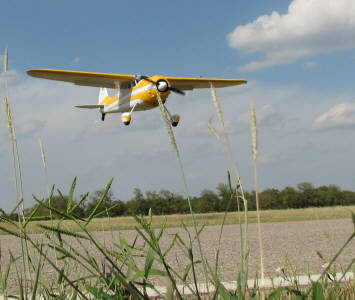
|
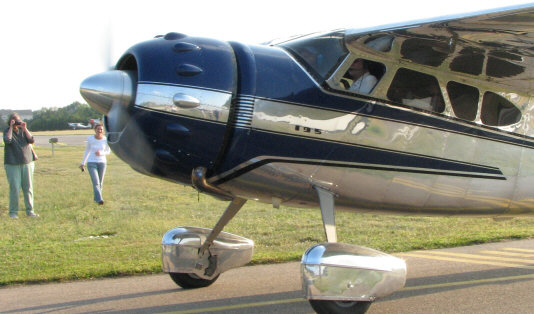 For the 80th anniversary of Cessna Aircraft, and the 60th anniversary of it's first all-metal airplane -- the 190/195 -- the International 195 Association held its annual fly-in at Stearman Field in Benton, Kansas -- just outside Cessna's hometown (Wichita).
For the 80th anniversary of Cessna Aircraft, and the 60th anniversary of it's first all-metal airplane -- the 190/195 -- the International 195 Association held its annual fly-in at Stearman Field in Benton, Kansas -- just outside Cessna's hometown (Wichita).
For five rollicking days, round-engines and tailwheels swarmed around the region, and the airfield was a rainbow of colorfully trimmed gleaming aluminum art -- frequently springing to life for a dance in the traffic pattern -- as old friends met, and new friends were made.
Among the attendees I got to meet and visit with: Cessna CEO Jack Pelton, and 99-year-old, legendary Cessna test pilot Mort Brown.
For more,
CLICK HERE
|
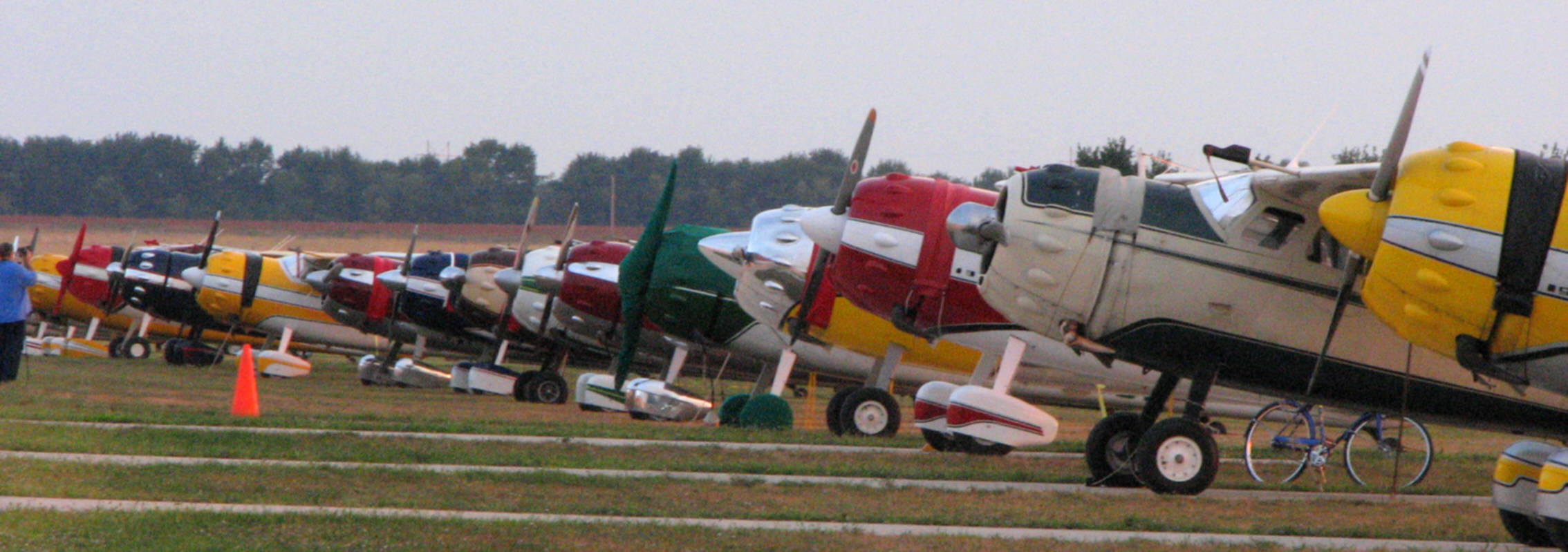
|
|
|
US Air Races 2007
Jabara Airport, Wichita, July 16 - 17, 2007
|

|

The
2007 U.S. Air Races, starting in Wichita, included a local race, and the 1,800-mile Marion P. Jayne cross-country race, which started from Wichita's Jabara Airport. The destination: Steven's Point, Wisconsin, for a final local race, and on to Oshkosh for a celebration at the world's biggest fly-in.
Every kind of light plane imaginable participates in these "handicapped" races, true tests of pilot skill, navigating against the unpredictable winds and weather, delicately managing engine conditions -- while racing full-throttle across the country.
At the starting line, I examined the race planes, interviewed pilots, and photo'd the event up close and personal.
For more,
CLICK HERE
|
|
|
National Air Tour,
Sept. 8–24, 2003
Enroute layover at Jabara Airport, Wichita,
Fri.-Mon., Sept. 12-15
|
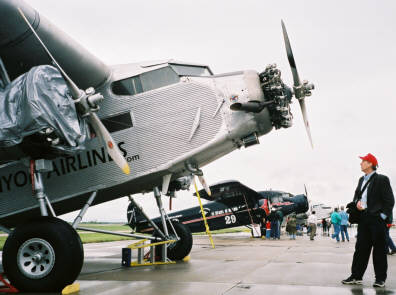

|
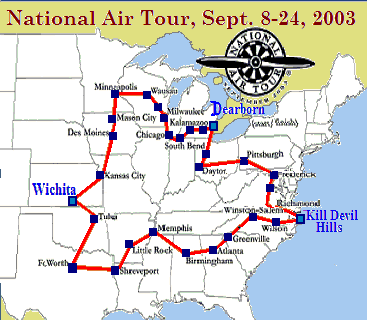
The 2003 National Air Tour, starting in, and returning to, Dearborn, Michigan, retracing the path of of the first of a series of famous, gigantic, nation-circling aerial rallys of the 1920s (sponsored by Dearborn's leading citizen, auto industry pioneer Henry Ford), which pushed plane-makers to produce reliable aircraft, while showing the nation what practical travel airplanes could provide. Wichita, "The Air Capital City," was one of the main (and longest) stops of the tour, then and now.
|
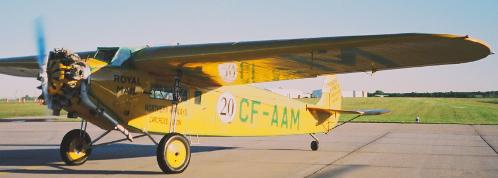

|
The "2003 National Air Tour" winds up for liftoff from Wichita. The multi-million-dollar orchestra of priceless aviating antiques -- all of them built in the 1920s and early 1930s, when the original Air Tours began -- made a fabulous rumble as they started up. An ancient, golden, wooden Fokker monoplane airliner (forerunner of the Fokker TriMotor) and a trio of trimotors (Ford, Stinson & Bushmaster), were just some of the 20 antiques touring the nation. Shown here on the Jabara Airport ramp are: an early Stearman,...
|
... a Great Lakes, a handful of cabin and open-cockpit Wacos, a Ryan monoplane (forerunner to Lindbergh's Spirit of St. Louis), and an Alexander Eaglerock -- all warming up to spread their wings -- as the last flying Ford Trimotor in commercial service stretches its protective wings in front of the gathering brood. Even more planes were off-camera, nearby. And oh, the deep-throated music of all these old radial engines purring together! For more on the National Air Tour and its Wichita visit,
CLICK HERE.
|
|
|
|
|
|
Close Encounters of the Rotary Kind
Jabara Airport, Wichita, July 16 - 17, 2003
|
|

|
During the "2003 National Air Tour,"
Up In the Air Pictures'
master videographer Michael McMaster hangs out on the skid of
Dr. Rich Sugden's
turbine-mod Bell 47 helicopter,
to "shoot" my photographer (Steve Alexander) and I, riding in the front cockpit of
Clay Adam's
1929 Curtiss-Wright Travel Air 4000
biplane. Naturally, we shot back. The escapade wasn't just for sport. It was for the made-for-TV documentary "The Barnstormers,"
for which I provided some historical consulting and image-hunting.
For more, from the Airport Journals article, "'The Barnstormers' — A Dollar and Desire,"
CLICK HERE
|
|
|
Airplanes & Airshows
in the Air Capital Area - 2000-2006
|

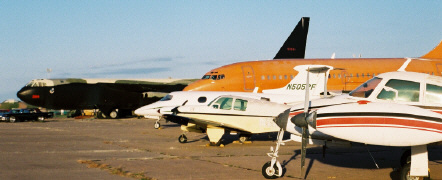
|
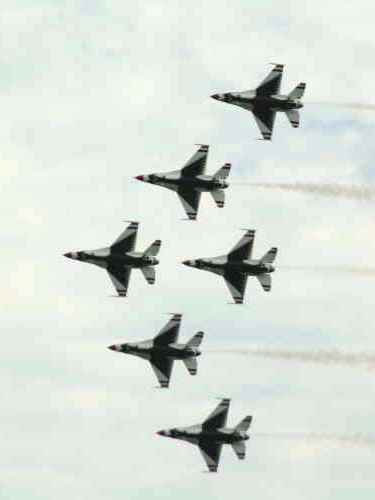
Antique airplanes, race planes, jet fighters, old warbirds, big jetliners, stunt planes, helicopters, giant bombers... a string of Wichita-area airshows and fly-ins gave me an up-close look at more exotic aircraft than I can remember.
Here's just a sampling of the fascinating sights at Air Capital area airshows, fly-ins, exhibitions and events, from the late 1990s to the early 2000s.
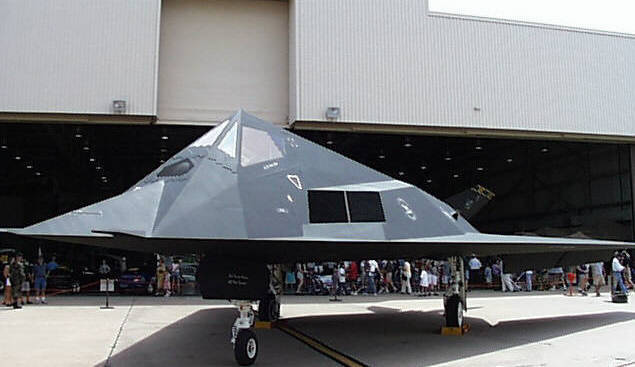
|
|


Not content to watch the shows,
I sometimes participate.
Here, with veteran national
airshow announcer
John "Hoot" Myers
(of KAKE-TV local fame),
I add "my two-cents worth"
-- a running "color commentary"

on the history of the planes
as they fly by.
Guess which one I flew?
For more,
CLICK HERE.
|
|
|
|
Mirror, mirror, on the plane: Who's the photographer, and what's his name?
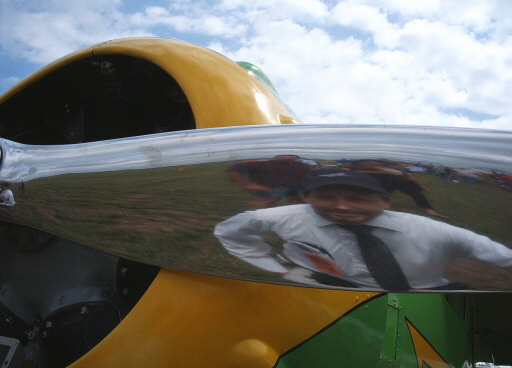
Yep, that's me, reflected in the gleaming prop of a restored 1930's Cessna Airmaster.
I'll leave it to your imagination as to how I took the picture.
|
|
 Return to
Return to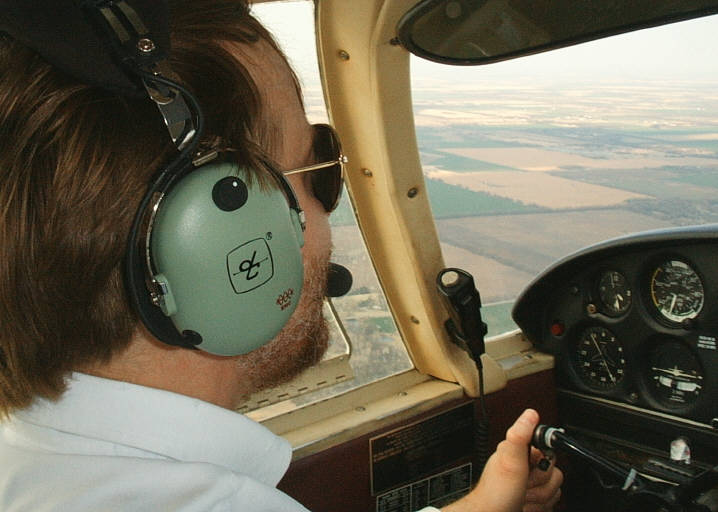
 Return to
Return to


















 As a volunteer "docent" at the EAA Museum, I did lots of "drudge chores," but also got to spend hours with visitors from around the world, happily explaining the history and significance of the staggering array of historic aircraft and other exhibits in this world-class aviation museum.
As a volunteer "docent" at the EAA Museum, I did lots of "drudge chores," but also got to spend hours with visitors from around the world, happily explaining the history and significance of the staggering array of historic aircraft and other exhibits in this world-class aviation museum.



 and provided some on-camera historical commentary.
The film was
and provided some on-camera historical commentary.
The film was  Space Shuttle program, and the layoff of 24,000 aerospace industry workers.
Space Shuttle program, and the layoff of 24,000 aerospace industry workers.
 Noting my knowledge of Wichita's aviation industry, and its history, they sought my commentary, in print and on-camera, about the prospects of creating another "Air Capital City" on the Space Coast. (Reflecting on the difficulties of establishing an Air Capital, past and present, I encouraged them to focus efforts, instead, on becoming the "Alternative Energy Capital," based on their special skills, resources and market realities.)
For more,
Noting my knowledge of Wichita's aviation industry, and its history, they sought my commentary, in print and on-camera, about the prospects of creating another "Air Capital City" on the Space Coast. (Reflecting on the difficulties of establishing an Air Capital, past and present, I encouraged them to focus efforts, instead, on becoming the "Alternative Energy Capital," based on their special skills, resources and market realities.)
For more, 
 The Wright Brothers and the Development of Aircraft Structures, a history project, by a group of Indonesians, for National History Day (an American educational event now observed in nations around the world).
The Wright Brothers and the Development of Aircraft Structures, a history project, by a group of Indonesians, for National History Day (an American educational event now observed in nations around the world).



 but it was the only truly public commemoration of the anniversary in the state that month. Some key media responded, including newspapers who produced detailed features on the historic anniversary: the
but it was the only truly public commemoration of the anniversary in the state that month. Some key media responded, including newspapers who produced detailed features on the historic anniversary: the

 2010-2012:
2010-2012:
 Kansas turned 150 years old in 2011, and the two-year-long celebration, from 2010 to 2012, called for extra
attention from the state's humanities council, which provides expert speakers on various topics of Kansas history for public presentations throughout the state. Noting my
Kansas turned 150 years old in 2011, and the two-year-long celebration, from 2010 to 2012, called for extra
attention from the state's humanities council, which provides expert speakers on various topics of Kansas history for public presentations throughout the state. Noting my
 prior work on the topic, they invited me to develop and give the presentations on the history of the Kansas aviation industry. Over the next two years, I gave
prior work on the topic, they invited me to develop and give the presentations on the history of the Kansas aviation industry. Over the next two years, I gave 



 With the 2009 debut of the motion picture "Amelia," interest in the show's real-life subject, Kansas aviatrix Amelia Earhart -- the most famous of women aviators -- saw a resurgence.
With the 2009 debut of the motion picture "Amelia," interest in the show's real-life subject, Kansas aviatrix Amelia Earhart -- the most famous of women aviators -- saw a resurgence.

 The maker of Learjet and Challenger bizjets sponsors this annual week-long safety seminar for nearly 400 bizjet pilots, mechanics and flight dept. chiefs, from around the world -- billed as a sort of "Top Gun" school for corporate and charter jet pilots.
The maker of Learjet and Challenger bizjets sponsors this annual week-long safety seminar for nearly 400 bizjet pilots, mechanics and flight dept. chiefs, from around the world -- billed as a sort of "Top Gun" school for corporate and charter jet pilots.


 Above, a pair of early-1930s Stearmans converge, as a red WACO approaches. Below, Hank Galpin and his grand 6-seat (plus tiny bathroom) 1928 Travel Air 6000B (I'm in the pilot's seat, in the photo at right). At bottom is a Stinson Junior, a big, roomy 4-5 seater of the early 1930s. Not shown: a luxurious red WACO cabin biplane.
Above, a pair of early-1930s Stearmans converge, as a red WACO approaches. Below, Hank Galpin and his grand 6-seat (plus tiny bathroom) 1928 Travel Air 6000B (I'm in the pilot's seat, in the photo at right). At bottom is a Stinson Junior, a big, roomy 4-5 seater of the early 1930s. Not shown: a luxurious red WACO cabin biplane.







 Wichita's a truly good airshow town, when it has one. The 2008 Wichita Flight Festival gathered some of the most famous names in the airshow biz: Patty Wagstaff, John Mohr, Julie Clark, Corky Fornof, Greg Shelton & Ashley Battles, the Red Eagles, the Aeroshell T-6 team, and more, for a three-day spectacle.
Wichita's a truly good airshow town, when it has one. The 2008 Wichita Flight Festival gathered some of the most famous names in the airshow biz: Patty Wagstaff, John Mohr, Julie Clark, Corky Fornof, Greg Shelton & Ashley Battles, the Red Eagles, the Aeroshell T-6 team, and more, for a three-day spectacle.

 So many great sights to shoot, and so little free time! My photos are supplemented with brilliant work by photographer/buddies Kira Corteville, and Steve & Sheri Alexander.
So many great sights to shoot, and so little free time! My photos are supplemented with brilliant work by photographer/buddies Kira Corteville, and Steve & Sheri Alexander.



 One of the great gatherings of double winged birds, this was the last of BAA's annual national fly-ins in Bartlesville, Okla. Dozens of vintage and modern biplanes of every type flocked to the field, showing off and cavorting in the sky. A few sold rides, and we took one!
For more,
One of the great gatherings of double winged birds, this was the last of BAA's annual national fly-ins in Bartlesville, Okla. Dozens of vintage and modern biplanes of every type flocked to the field, showing off and cavorting in the sky. A few sold rides, and we took one!
For more,




 For the 80th anniversary of Cessna Aircraft, and the 60th anniversary of it's first all-metal airplane -- the 190/195 -- the International 195 Association held its annual fly-in at Stearman Field in Benton, Kansas -- just outside Cessna's hometown (Wichita).
For the 80th anniversary of Cessna Aircraft, and the 60th anniversary of it's first all-metal airplane -- the 190/195 -- the International 195 Association held its annual fly-in at Stearman Field in Benton, Kansas -- just outside Cessna's hometown (Wichita).
















